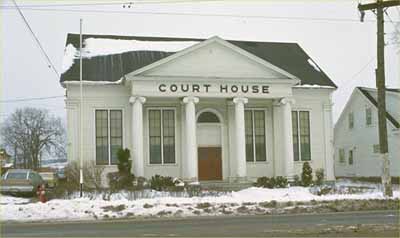Antigonish County Court House National Historic Site of Canada
Antigonish, Nova Scotia

Façade
(© Parks Canada Agency/ Agence Parcs Canada, 1987.)
Address :
170 Main Street, Antigonish, Nova Scotia
Recognition Statute:
Historic Sites and Monuments Act (R.S.C., 1985, c. H-4)
Designation Date:
1981-11-13
Dates:
-
1855 to 1855
(Construction)
Event, Person, Organization:
-
Alexander McDonald
(Builder)
Other Name(s):
-
Antigonish County Court House
(Designation Name)
Plaque(s)
Existing plaque: 170 Main Street, Antigonish, Nova Scotia
The Antigonish County Court House, constructed in 1855, is one of the best examples in Nova Scotia of the typical mid-19th century Maritime court house. The simple vernacular style of this building is enhanced by the Greek Revival temple-like portico which is its distinctive feature. Alexander McDonald, local carpenter and builder, designed and built this court house in addition to those at Sherbrooke and Arichat. The county court house has remained as a focal point of judicial and community activity since the mid-19th century.
Approved 1982
Description of Historic Place
Antigonish County Court House is situated in the town of Antigonish on the northeastern shore of mainland Nova Scotia. Built in a simple, vernacular style, the Court House is symmetrical, wood-frame building. It is distinguished by a Greek revival, temple-like front consisting of a pedimented portico supported by four large fluted columns. The county jail, built of stone, is attached at the rear. Official recognition refers to the building on its legal lot.
Heritage Value
Antigonish County Court House was designated a national historic site of Canada in 1981 because it is one of the best examples in Nova Scotia of the typical mid-19th century Maritime Court House.
The court houses erected in Nova Scotia toward the mid-19th century were small wooden buildings which accommodated a large court room, a judge’s chambers, a barrister’s room, as well as rooms for grand and petit juries. They were simple frame buildings, the design of which incorporated classicized ornamental details, giving them a monumental presence suitable for courts of law. The Antigonish Court House is a good example, designed and constructed in 1855 by local carpenter Alexander McDonald. The building has undergone some modifications, having survived a major fire in 1945 and having undergone subsequent renovations. It continues to serve as a court house.
Source: Historic Sites and Monuments Board of Canada, Minutes, November 1981.
Character-Defining Elements
The key elements that contribute to the heritage character of this site include:
the two-and-a-half storey , rectangular massing under a front-sloping gable roof; the wood-frame construction with clapboard siding; the symmetrical principal elevation with pedimented portico supported by four large voluted columns of the Greek Ionic order; the five-bay façade with central principal entrance and regularly placed double-height, multi-pane windows; the wooden exterior detailing that includes a prominent pediment, a wide frieze under the eaves, a series of fluted pilasters marking the bays of the façade; the double doors of the main entrance with a semi-circular fanlight above; surviving evidence of the original features, finishes, and the original interior configuration defined by the large courtroom directly beyond the high main entry vestibule with split stairs leading to a gallery above.